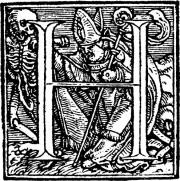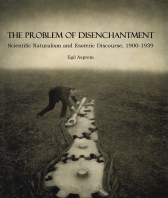As a member of what’s been called the “brat pack” of esotericism scholars I am proud to note that a considerable number of us are appearing on the scene this year with monographs based on PhD dissertations. The brat pack presumably consists of a group of (then) students and emerging scholars who were around at the time of ESSWE 1 in 2007, and who have frequently been seen together at conferences since. While some of us have teamed up for joint gigs in the past (think The Devil’s Party or Contemporary Esotericism, and the conferences that went with both of these), it looks like 2014 is the big year for solo work. I know of at least four titles either published or forthcoming in 2014 by (for the most part) recent PhDs working in the field of Western esotericism. There may be other publication plans I am not aware of (please leave a note!). Here’s a chronological list of the knowns.
Looking through the Occult – talks available as podcasts
Last November I took part in an interesting interdisciplinary conference at the Humboldt in Berlin, on “Looking through the Occult: Instrumentation, Esotericism, and Epistemology“. It moved in the landscape of media studies, history of science and technology, religious studies, art history, and esotericism, and was organized by a scholarly network interested in what they call “nonhegemonic knowledge”:
Looking through the Occult: Conference on Instrumentation, Esotericism and Epistemology in the 19th Century (Humboldt U, Berlin)
I’m excited to participate in a wonderful conference at Berlin’s Humboldt University on November 14-15: “Looking through the Occult: Instrumentation, Esotericism and Epistemology in the 19th Century”. The conference is free and open to the public, so if you are in Berlin and have an above average interest in topics such as spiritualism and mediums, ether physics, spirit photography, early radio technology and x-rays, this should be a good treat. Check out the nice website for more information on the programme, how to get there, and what to read up on in advance.
Scientific delusions, or delusions about science? (Part four: on natural laws and resonating habits)
It has been a while since my last post on Rupert Sheldrake’s Science Delusion, or, as it is called in the United States version (published by none other than Deepak Chopra Books – no doubt a token of proper peer-reviewed science), Science Set Free. For new readers as well as for old ones who need to refresh their memories, previous installations in the series are found here, here, and here. Without further ado, let me get started on an evaluation of the fourth dogma ascribed to science: “The laws of nature are fixed”. As in previous posts, evaluating this dogma (and whether it is one to begin with) will occasion a few short excursions in the philosophy and history of science. But this time we are also led, finally, to confront Sheldrake’s own key thesis, namely his theory of “morphic resonance”. Read on if you’re still curious.
Scientific delusions, or delusions about science? (Part three: muddled conservations)
In the previous post on Sheldrake’s Science Delusion I discussed the first two dogma, concerning the “mechanical philosophy” and its challenges, and the question of whether matter is conscious. As we saw there, Sheldrake comes out as a sort of modern-day vitalist (even though he claims to be an organicist I think his anti-materialism is actually more radical, placing him in the vitalist camp), and a mild supporter of panpsychism. In the present installment we shall look at the third dogma, where Sheldrake takes on a central conceptions of physics: that the matter and energy of the universe is constant, and subjected to laws of conservation and conversion.
The Problem of Disenchantment – invitation to a PhD defence
Last autumn I completed my PhD dissertation, and now it’s time to defend it. The defence is public, and will take place on February 5, 2013, at 12:00 in the Agnietenkapel of the University of Amsterdam. The event is open to anyone (with a max. capacity of 90 people), and I will give a short public lecture on the topic of my research prior to defending it in front of the committee.
While I have given hints about my research in a number of posts here at Heterodoxology, I am now happy to present an official abstract of the final product – the dissertation itself:
Religion and Scientific Change: The Case of the New Natural Theologies between the World Wars (2/2)

Today, July 4 2012, Cern announced the likely detection of the elusive Higgs boson – known by the popular press as the “God particle”.
Last installment of my lecture on “Religion and Scientific Change” closed by introducing three levels on which claims about relationships between religion and science should be analysed: the institutional, the socio-cultural, and the individual. I was going to wait a couple of days with releasing the rest, but since news headlines today have been all about the discovery of the “God particle” in the bowels of the Large Hydron Collider at Cern, it seemed highly appropriate to continue. Why is it that such a (truth be told, rather ridiculous) religious pet-name has been put on the elusive boson? Read on, and you might find out. (And: happy Higgs boson day!)
Religion and Scientific Change: The Case of the New Natural Theologies between the World Wars (1/2)
 Earlier this spring I gave an Illustre School lecture at Spui25 in Amsterdam, on the lofty topic of the relationship between science and religion in the early 20th century. A significant part of my PhD dissertation concerns this topic, and I hope that the lecture provides a relatively accessible (=popularized) account of some of the questions I grapple with there. There is also a methodological concern in this lecture. As the abstract stated:
Earlier this spring I gave an Illustre School lecture at Spui25 in Amsterdam, on the lofty topic of the relationship between science and religion in the early 20th century. A significant part of my PhD dissertation concerns this topic, and I hope that the lecture provides a relatively accessible (=popularized) account of some of the questions I grapple with there. There is also a methodological concern in this lecture. As the abstract stated:
Since the European Enlightenment, the relation between science and religion has been a topic of much public interest. Usually, however, it has been a debate formed by heavily vested interests: in the 19th century, scientists attacked organized religion as a part of their emancipation from the church; vice versa, religious spokespersons have been eager to claim compatibility between doctrines of faith and emerging new authoritative views on nature. Even today, it remains the case that most academic research on relations between science and religion are driven either by the current “new atheism” vogue, or funded by religiously motivated organizations, such as the massively influential Templeton Foundation. The result has been a loss of nuance and critical perspective. In order to remedy this situation, one needs, on the one hand, to broaden the scope and look at the wider social contexts of scientific knowledge production and interaction with religious institutions, and, on the other, to be more precise by looking at particular instances of such interaction.
Continuing my practice from an earlier talk on a similar topic, I will make the manuscript of the lecture available here, in two installments. You’ll find the first part below.
Review: Mark Morrisson’s “Modern Alchemy”
 (The following is my review of Mark Morrisson’s Modern Alchemy. The final version was published in Aries 11.1).
(The following is my review of Mark Morrisson’s Modern Alchemy. The final version was published in Aries 11.1).
In 1901 physicist Ernest Rutherford and chemist Frederick Soddy, tucked away in a laboratory at McGill University, Montreal, Canada, were struck with amazement as they watched the element thorium transform into an inert gas. Soddy, exclaiming that they had witnessed nothing less than transmutation, was warned by his more temperate colleague: “For Mike’s sake, Soddy, don’t call it transmutation. They’ll have our heads off as alchemists”.
Alchemy would, however, be invoked frequently during the decades to come; not with reference to obscure occultists in the secret vaults of hermetic societies, but in connection to new discoveries concerning radioactive decay. Indeed, in its the early decades, what would become nuclear physics was commonly labelled “modern alchemy”. The crucible and athanor had been replaced by cloud chambers, spectroscopes, and ionization chambers, but there was a nagging feeling that the ancient and modern alchemists ultimately shared the same goal: the transmutation of elements.
Blind Spots of Disenchantment (3/3)
 The third and last part of my paper on the “Blind Spots of Disenchantment” focuses on the somewhat neglected concept of Weber’s 1918 “Wissenschaft als Beruf” paper: “the intellectual sacrifice”. It looks particularly at the Scottish Gifford Lectures’ attempt to promote a new “natural theology”, and suggests that this whole attempt defies Weber’s emphasis that science and religion are being/ought to be kept apart in a disenchanted modern world. It also includes the complete bibliography for all three parts.
The third and last part of my paper on the “Blind Spots of Disenchantment” focuses on the somewhat neglected concept of Weber’s 1918 “Wissenschaft als Beruf” paper: “the intellectual sacrifice”. It looks particularly at the Scottish Gifford Lectures’ attempt to promote a new “natural theology”, and suggests that this whole attempt defies Weber’s emphasis that science and religion are being/ought to be kept apart in a disenchanted modern world. It also includes the complete bibliography for all three parts.









